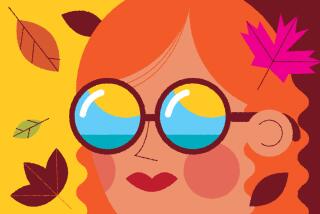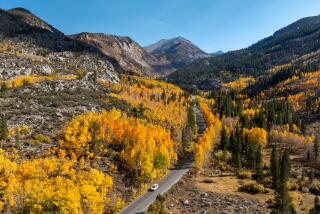Autumn Leaves : The Valley Version of Fall’s Color Show
The San Fernando Valley may not look like New England in the fall, but it has enough to satisfy leaf peepers. Fall color is the result of ample city planting of deciduous trees (those that shed leaves) and the existence of a few native species in the Santa Monica Mountains.
The region isn’t cold or wet enough to harbor a large variety, but the trees that are here thrive along streams in mountain canyons and sunny neighborhood parkways. Triggered by cool weather and less sunlight, native trees such as sycamores and cottonwoods and ornamentals such as liquidambar trees and Modesto ash light up in fall.
And there is no need to worry about loss of these trees after last year’s firestorms. Because the deciduous variety prefers stream-side habitat, not many were lost. Most had shed their leaves by November, so the fires inflicted only superficial damage.
Why Leaves Change Color
All leaves contain pigments that cause yellow, orange and red colors. For much of the year these are masked by chlorophyll, the primary light-catching pigment that accounts for the green color of plants. With shorter days and cooler nights, chlorophyll breaks down and these “accessory” pigments take over.
Pigments and the colors they cause:
* Green: From chlorophyll
* Yellow: From xanthophyll
* Orange-red: From carotene
* Red and purple: From anthocyanin
What Triggers the Change?
1. Phytochrome is a light-detecting pigment that cues the leaf when the days get shorter.
2. Chlorophyll begins to break down and the leaf loses its food-making capability.
3. Accessory pigments take over, helping to trap light and funnel it to chlorophyll.
4. As leaves change color, nutrients are pumped back into the tree trunk and roots, where they are stored until spring.
Food-Making Leaf
Through photosynthesis, the leaf captures energy from sunlight and turns it into food.
* Blade has green food-making cells and is where photosynthesis occurs.
* Veins carry food and water, as well as support the blade.
* Petiole contains tubes that carry water to the leaf and carry away food made by the leaf.
** A leaf can no longer make food after chlorophyll breaks down. The leaf falls from the tree when a corky layer forms across the leaf stalk.
Local Color
Opportunities to see deciduous trees changing color around the Valley are best where trees have been plante. Some colorful areas:
* West Valley: Warner Center poplars turn yellow. Brilliant red liquidambar (sweet gum) trees can be found on Lindley Avenue from Reseda into Northridge. Modesto ash turns yellow along Winnetka Avenue from Oxnard Street to Victory Boulevard.
* East Valley: A mix of older trees, mostly maples but also liquidambar, ash and sycamores, predominate. North Hollywood is home to colorful red and silver maples. A two-block stretch of Killion Street, from Tilden east, has many liquidambar trees.
Colorful Natives
Only a few tree species that turn bright exist in the area. Best places to see autumn displays are in the Santa Monica Mountains, especially Malibu Creek, Tapia Park, Sycamore Canyon and Solstice Canyon.
Cottonwood
“Fremont” type prefers wet soil along streams, turns bright yellow.
Sycamore
“Western” or “California” type is found along streams in foothills and mountains. Its leaves are large and turn gold.
Valley oak
Reaches its southern extent in rolling hilly areas of the Santa Monicas. Its large, lobed leaves turn light golden brown.
Big-leaf maple
Fairly uncommon, found in Santa Monicas along streams. Its leaves turn yellow and orange.
Sources: Audubon Society Field Guide to North American Trees, Western Region; City Department of Public Works; National Park Service; Native Plant Society; Steve Davis, Pepperdine University; Researched by Julie Sheer / Los Angeles Times
More to Read
Sign up for The Wild
We’ll help you find the best places to hike, bike and run, as well as the perfect silent spots for meditation and yoga.
You may occasionally receive promotional content from the Los Angeles Times.






